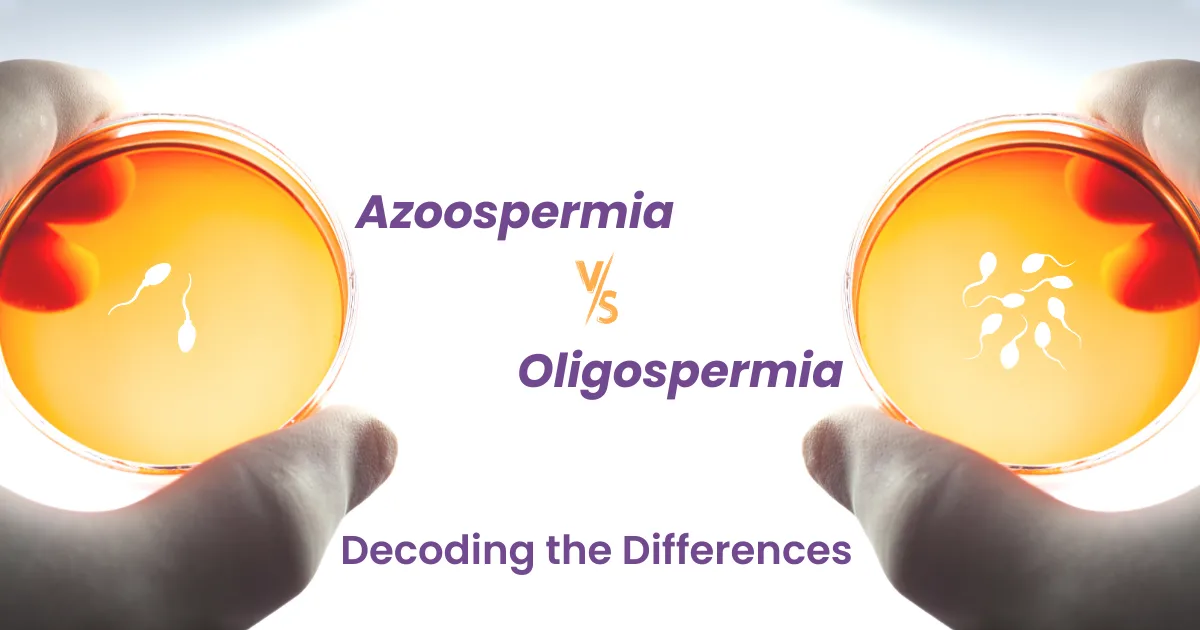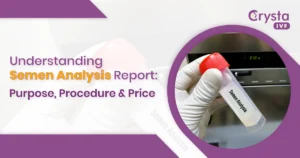When it comes to male fertility, two terms that are often discussed are azoospermia and oligospermia. Both these medical words have a Greek origin. These conditions refer to the absence or low concentration of sperm in a man’s ejaculate, respectively.
A Study
Infertility affects a significant portion of the population in India, and studies have shown that male infertility is an essential contributor to couples’ difficulties in conceiving. According to a study published in the Indian Journal of Urology, the incidence of male infertility in India is estimated to be between 8-12%.
Additionally, a study published in the Journal of Human Reproductive Sciences found that low sperm count, also known as oligospermia, is a common cause of male infertility in India, accounting for up to 30% of cases.
Understanding the differences between these two conditions is essential for anyone seeking to understand their own fertility or that of a partner. In this blog, we will compare azoospermia and oligospermia and discuss the causes, symptoms, types, and treatment options for each.
Whether you are trying to conceive naturally or considering assisted reproduction, it is essential to understand the potential impact of these conditions on your fertility.
So, let’s dive in and explore the differences between azoospermia and oligospermia.
What is Azoospermia?
Azoospermia is a medical condition with a complete absence of sperm in the semen sample. It is a relatively rare condition, affecting only 1% of men worldwide, and accounts for 20% of male infertility cases.
At least two semen samples should be considered before diagnosing a male with azoospermia due to fluctuations between samples.
In most cases, the cause of azoospermia is unknown; some of the most common causes include:
- Blockage in the testicular ducts
- Obstruction in reproductive organs
- Genetic defects
- Anatomical disorders
- Hormone imbalances
- Infections
What is Oligospermia?
Oligospermia, also known as oligozoospermia, on the other hand, is defined as a low concentration of sperm in a man’s ejaculate. It usually means fewer than 15 million sperm per milliliter of semen. It can affect a man’s fertility and make it difficult to conceive.
Oligospermia can have a variety of causes, including –
- Age
- Lifestyle factors (such as smoking or drug use)
- Varicocele
- Infection
- Inflammation
- Genetic defects
- Hormonal imbalances
- Physical abnormalities
- Medical conditions such as diabetes and obesity
- Exposure to certain toxins or radiation
Oligospermia can also be caused by a lack of testosterone, the hormone that regulates sperm production.
Types of Azoospermia
There are different types of azoospermia, which are categorized based on the underlying cause of the condition. The most common types are:
Obstructive azoospermia
This occurs when there is a blockage in the sperm ducts that prevents the passage of sperm. Several factors, including a congenital blockage, infection, or injury, can cause this.
Non-obstructive azoospermia
This occurs when there is no blockage in the sperm ducts, but there is a problem with sperm production. Several factors, including genetics, testicular injury, radiation, or certain medical conditions, can cause this.
Despite them, azoospermia can also be categorized into Secretory azoospermia and Cryptozoospermia. It’s important to note that some men may have a combination of these types.
Types of Oligospermia
Oligospermia is classified into 3 categories:
- Mild oligospermia is characterized by a sperm count of approximately 10 to 15 million sperm per milliliter.
- Moderate oligospermia is identified by a sperm count of roughly 5 to 10 million sperm per milliliter.
- Severe oligospermia is defined as having a sperm count of 0 to 5 million sperm per milliliter.
What Treatment Options for Azoospermia?
Azoospermia is usually diagnosed through semen analysis, which measures the number of sperm present in a sample.
Treatment options for azoospermia will depend on the underlying cause of the condition, such as :
- For instance, if an infection causes the condition, antibiotics may be necessary.
- In some cases, surgery may be able to correct an obstruction in the reproductive tract.
- If hormones are to blame, medications may be prescribed to regulate them.
- There are also assisted reproductive techniques that can be used to help couples conceive, even if the man has azoospermia.
- In other cases, treatments such as sperm retrieval techniques may be used to extract sperm from the testicles or epididymis.
What Treatment Options for Oligospermia?
Oligospermia treatment can vary depending on the underlying cause but may include lifestyle changes, medications, or surgery. While oligospermia can affect fertility, a man with the condition can still father a child.
For oligospermia, treatment may include –
- Lifestyle changes
- Surgery for conditions like Varicocele
- Hormone therapy
- Genetic counseling
- Medications or antibiotics
In other cases, assisted reproductive techniques such as in vitro fertilization (IVF) with intracytoplasmic sperm injection (ICSI) may be recommended. It is essential to consult with a fertility specialist if you are experiencing any symptoms of oligospermia.
Azoospermia VS Oligospermia
| Azoospermia | Oligospermia | |
|---|---|---|
| Meaning | A medical condition of no sperm count in males | A condition in which a male has a lower-than-normal sperm count. |
| Symptoms | Low sex drive, erectile dysfunction, discomfort around the testicles, decreased hair on the face or body, etc. | Decrease in semen volume & sperm motility, difficulty conceiving, low sex drive, etc. |
| Types | 1. Obstructive azoospermia 2. Non-obstructive azoospermia 3. Secretory azoospermia 4. Cryptozoospermia | 1. Mild oligospermia (10 to 15 million sperm/mL) 2. Moderate oligospermia (5 to 10 million sperm/mL) 3. Severe oligospermia (0 and 5 million sperm/mL) |
| Causes | Infections, inflammation, injury, vasectomy, genetics, hormone disorder, blockages, etc. | Lifestyle factors, environmental toxins, genetics, infections, heat, obesity, varicocele, etc. |
| Diagnosis | Includes semen analysis, fertility history, medical history, hormone tests, brain imaging, ultrasound, and biopsies | includes semen analysis, urinalysis, genetic testing, and imaging tests |
| Treatments | May include surgery, medication or counseling, antibiotics, hormone treatments, assisted reproductive technology such as IVF with ICSI | May include surgery, medications, antibiotics, hormone treatment, lifestyle changes, and reproduction assistance |
| What’s next? | Consult a fertility expert today | Consult a fertility expert today |
In Conclusion
Azoospermia and oligospermia are two conditions that can have a significant impact on male fertility. Understanding the differences between these conditions, as well as the causes, symptoms, and treatment options, can help men and couples make more informed decisions when it comes to their reproductive health.
It is essential to consult a fertility specialist if you are experiencing difficulty in conceiving or if you suspect you may have azoospermia or oligospermia.
Fertility specialists at the best IVF center in Delhi at Crysta IVF will be able to evaluate your specific situation and help you understand the best options for treatment that would help in increasing the chances of you fathering a child.




